|
The Alfa Romeo and Ferrari communities
suffered a huge loss earlier this month with the death of Giuseppe Busso. The great engineer passed away on Monday 3rd January, aged 92, in Arese near Milan.
Busso was one of the most important engineers in the history
of the two Italian marques, and his innovations, influence
and genius has been wrought into into the fabric of Alfa
Romeo and Ferrari.
Giuseppe Busso was born in Turin in 1913, where he later gained his diploma in industrial engineering. In 1937, after military service, Busso started to work as a calculator at Fiat's technical aeronautical engine department (Ufficio Tecnico Motori Aviazione / UTMA) before later moving on to the technical experimental locomotive railway office (Ufficio Tecnico Autoveicoli Ferroviari Sperimentali / UTAFS).
At the beginning of January 1939, Busso moved to Alfa Romeo where he immediately started to work in the special projects office (Servizio Studi Speciali) created by the Spanish designer Wilfredo Ricart (who later went on to establish Pegaso in his native homeland). In particular, Busso developed racing car engines and worked directly under Ing. Orazio Satta Pulìga. Here Busso worked as a researcher, developing technical theories with the aide of Satta. His work was lectured at the Turin Polytechnic, which resulted in Busso becoming a protagonist of the establishment.
The engineer was hired by Enzo Ferrari as his first technical director in 1946. This new job, which Busso started on 10th June, was arranged by the legendary Alfa Romeo engineer Gioachino Colombo. At the time Colombo worked as a consultant for Enzo Ferrari during development of his first car, the Ferrari 125 Sport (the name indicating the individual cubic capacity of each of the 12 cylinders). With the design of this car, Colombo had been aided by Angelo (Lino) Nasi, the former Alfa Romeo industrial vehicle technical director, who designed the Ferrari's 5-speed gearbox and rigid rear axle.
By November 1945 Colombo had recommenced work at Alfa Romeo, and had recommended to Enzo Ferrari that he should hire Busso in order to oversee development of the new V12 engine. Between December 1945 and January 1946, the 125 Sport project's technical drawings were delivered to component manufacturers. However, from then on little progress was achieved. Despite this, Enzo Ferrari was certain that his own technical staff were more than capable of developing the engine. But when Ferrari realised that this was not the case, he accepted Colombo's advice and met Busso on 15th May 1946 to arrange for him to become his new technical director.
Busso's task at Ferrari was to control development of the 125 Sport project and to design the four-cam, two stage supercharged 1.5-litre V12 Grand Prix car which would first race in September 1949. Busso joined Luigi Bazzi at the Modena factory which was still occupied in producing machine tools in order to generate capital for the new car company known simply as Ferrari, Modena, Italy. Together with his assistant Aurelio Lampredi, who officially started work on 2nd October 1946 (although was already working in the workshop at the end of September), Busso oversaw the development of the 60° V12, 1,497 cc Colombo engine. In Touring form, the engine produced 72 bhp at 5,600 rpm.
The first 125 Sport (chassis 01 C) was ready on the 12th March 1947, and the model debuted in May of that year at the Piacenza racing circuit. Featuring transverse leaf sprung suspension and a 2,489 mm wheelbase, the 125 Sport weighed in at a mere 750 kg. A Ferrari 125 Sport later won the 1947 Mille Miglia with drivers Clemente Biondetti and Giuseppe Navone, and with this the Ferrari legend grew as a manufacturer of Italy's finest cars. After a disagreement with Orazio Satta, Gioachino Colombo left Alfa Romeo in December 1947. This was most probably due to conflicting part-time activities in designing the Ferrari and the ‘Volpe' (another car project). This move left a position vacant for Busso, and he restarted work at Alfa Romeo after being approached by Satta in January 1948.
|
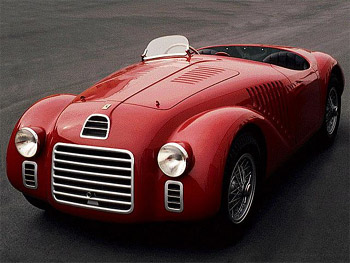
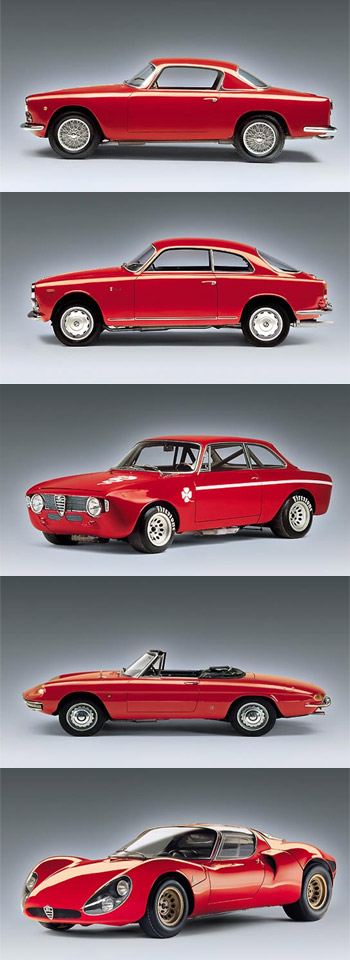 |
Top:
Ferrari's recreation of the 125 S from 1947. Above:
A selection of formidable Alfa Romeos engineered by Giuseppe Busso. |
|
|
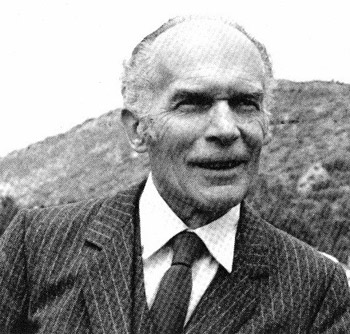
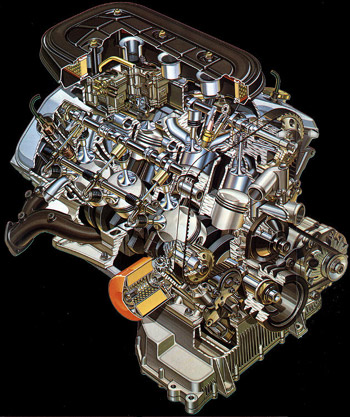
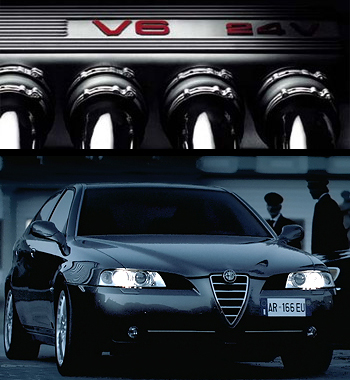 |
Above: Giuseppe Busso, 1913-2006, will be remembered as one of Alfa Romeo's greatest engineers. Centre:
the 2.5-litre V6 engine used in the 1979 Alfa 6 was the last project which Giuseppe Busso worked on prior to his retirement in 1977. Below: evolutions of the 'Bussone V6' engine design can be ordered in the Alfa GT and Alfa 166, as well as the Lancia Thesis and Phedra flagship models. |
|
|
Busso became responsible for the mechanical components design department, and from then studied and planned new projects for all the Alfa Romeo models that were produced at Portello and later at Arese. This started with the 1900 and the Giulietta during the late ‘40s and early ‘50s.
With the Giulietta, Busso introduced a revolutionary twin cam 1,290 cc engine that benefited from extensive use of aluminium alloy, a highly advanced idea at the time. This engine, forerunner of all subsequent 4-cylinder Alfa Romeo engines, was designed by Busso in accordance with a philosophy of weight containment that came from his training as an aviation engine designer.
Busso's work culminated in the 1979 Alfa 6, which was the first production Alfa Romeo to boast a V6 engine. This model also represented the last Alfa Romeo executive flagship to be built by the Milanese company before the Fiat take-over in 1986.
The Rudolf Hruska-designed Alfasud was the only exception to Busso's reign as chief engineer at Alfa Romeo, although this compact car was arguably a government project instated by INCA, the Industria Napoletana Costruzione Autoveicoli, a separate company which continued to build the boxer-engined cars until it was dissolved by the government at the time of the Fiat buy-out.
Despite this, Busso did work on the first prototypes of a front wheel-drive small car for Alfa Romeo. The first of these, Tipo 13-61, was nearly realised in 1952. The baby Alfa was fitted with a transverse water-cooled 2-cylinder 750 cc engine, which in effect was half a Giulietta 1300 unit (at the time, the Giulietta was still in the development phase). Unfortunately, the project fell through due to unrealistic production costs, or as some believe a gentleman's agreement with Fiat as not to interfere with each others market. A second try in the early ‘60s resulted in the Tipo 103, which was a small four-door saloon with a transverse 1,000 cc 4-cylinder engine. Aimed below the Giulietta in size, the 103 had front wheel-drive and a 4-speed gearbox. The engine was able to produce 52 bhp at 5,500 rpm resulting in a top-speed of 130 km/h. The four-door bodywork was apparently very spacious and anticipated the design of the Giulia, for favour of which the project was suspended.
During his thirty years at Alfa Romeo, Busso held many titles: caposervizio in 1952, manager in 1954, vice director in 1966, director in 1969, vice-director general in 1972 and co-director general in 1973. He retired from Alfa Romeo in 1977. In the minds of Alfisti, Busso will be best remembered for the great classics: 1900 (including the 1900 M ‘Matta'), Giulietta, Giulia, Alfetta and the Alfa Romeo 2.5 V6 engine. It was this formidable motor, and its evolution thereof, which has represented the soul of Alfa Romeo for the past 25 years. It is without a doubt recognised as one of motoring's most respected engines. Busso was also responsible for the 6C 3000 CM, TZ, GTA and Tipo 33 competition cars, the latter models arriving with the naissance of the Autodelta racing department.
With the passing of Busso, we must also unfortunately remember the end of the ‘Bussone V6' era. The classic engine went out of production last year, with currently only the Alfa GT and Alfa 166, as
well as the Lancia Thesis flagship model being produced with this thoroughbred Italian heart. In some countries, there are still stocks of the GTV, Spider and GTA models also fitted with this engine. The Alfa 159 and Brera use a new generation 260 bhp V6 JTS engine with Twin Phaser technology, however its aluminium construction harks back to the classic Busso design.
Busso's funeral took place on Saturday 7th January at 10:30 at the San Pietro and Paolo church in Arese.
by James Granger
|
|
|
|
![]()
![]()